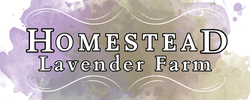🌿 What is lavender, exactly?
Lavender is a flowering plant from the mint family (Lamiaceae), cherished for its fragrant purple blooms, calming properties, and diverse uses. Each variety offers a different scent profile, oil yield, and purpose, ranging from floral and sweet to sharp and herbaceous. At Homestead Lavender Farm, we cultivate over 20 varieties, each with its own unique scent and role on the farm, from essential oils to culinary buds to fresh bouquets.
🌱 Is all lavender the same?
Not quite. Some lavender varieties are better for essential oil production, while others shine in bouquets, culinary recipes, or landscaping. At our Homestead, we cultivate English lavenders (Lavandula angustifolia), such as Royal Velvet and Vera, as well as hybrids (Lavandula × intermedia), including Grosso and Phenomenal, renowned for their fragrant qualities and high oil yields.
💧 What’s the difference between lavender oil and lavender essential oil?
Lavender essential oil is the pure, concentrated aromatic compound steam-distilled from the lavender plant.
Lavender oil may refer to a diluted blend of essential oil in a carrier oil or an infused oil made by steeping dried lavender buds in a carrier oil. Infusions are gentle and commonly used in skincare and bath products.
Think of essential oil as the strong black coffee of lavender. Infused or blended oils are more like steeped herbal tea—gentle, soothing, and suited for daily use.
🧺 What can lavender be used for?
- Aromatherapy and relaxation
- Bath and body products
- Home sprays and natural cleaners
- Culinary recipes (teas, syrups, baked goods)
- Floral arrangements and home décor
Our approach is simple: time‑tested traditions, clean ingredients, and natural goodness. And for even more creative uses? Just check out Pinterest—you’ll be amazed at what folks come up with!
📜 How was lavender used throughout history?
-
Ancient Egypt (c. 1500 BCE) – Used for mummification and perfumery.
-
Ancient Rome (1st century CE) – Added to bathwater; the name comes from lavare, meaning "to wash."
-
Middle Ages – Grown by monks for spiritual and medicinal use.
-
Victorian era – Prized in sachets, linens, and handwritten letters.
Across centuries and cultures, lavender has remained a symbol of serenity, purity, and nurturing care.
😌 Does lavender help you relax?
Many people find the scent of lavender naturally calming. It’s used in aromatherapy, pillow sprays, and massage oils to promote a relaxing atmosphere.
While we don’t make medical claims, we will say this: a walk through our fields is one of the most peaceful parts of the day.
🐾 Is lavender safe to use around pets and children?
Lavender hydrosol (our water‑based byproduct of distillation) is generally considered safe when used correctly. Essential oils are more concentrated and must be diluted before use, especially around pets or young children. Always consult a healthcare or veterinary professional before application.
🌾 How is lavender grown at Homestead Lavender Farm?
With intention, care, and a healthy respect for nature. We use:
- Raised rows and underground drip irrigation
- Weed barrier for moisture retention and labor reduction
- Rock amendments for drainage
- Occasional foliar sprays (based on annual soil testing)
We plan for Tennessee’s climate, from spring flooding to summer drought. Collaborating with the NRCS, we support pollinators, erosion control, and sustainable farming practices.
🧴 What’s the difference between lavender essential oil and lavender hydrosol?
Essential oil is the concentrated oil extracted via steam distillation.
Hydrosol is the aromatic water produced during the same process. Hydrosol is gentler—perfect for sensitive skin, pets, or linens.
🍰 Can I cook with lavender?
Yes! But choose the right kind. English lavender (such as Royal Velvet or Vera) has a sweeter, milder flavor, ideal for teas, syrups, and baked goods. We offer culinary-grade buds and handmade lavender syrup.
👃 Which lavender variety smells the strongest?
-
Grosso – Camphorous and strong; great for oils
-
Royal Velvet and Vera – Soft and sweet
-
Phenomenal – Balanced and versatile
Each variety has its personality—come sniff for yourself!
🌤️ Can I grow lavender in Tennessee?
Yes, with proper planning. Lavender loves:
- Full sun
- Well-drained soil (amended with rock)
- Raised rows and drip irrigation
- Annual soil testing to guide foliar sprays
We grow in Tennessee’s silt loam soil using all of the above. It’s doable with dedication!
🛒 What makes your lavender different from store-bought?
Ours is grown, harvested, and distilled right here in Tennessee. No synthetic fillers. No global shipping. Just real lavender—from our field to your shelf.
🚫 Do you use pesticides or herbicides?
We avoid synthetic inputs. Instead, we use weed mat, hand labor, and pollinator-friendly practices. On rare occasions, we spot-treat outer paths—but never the lavender rows themselves.
🐜 What diseases or pests affect lavender?
-
Root rot – Prevented by raised beds and good drainage
-
Septoria leaf spot – Managed with airflow
-
Spittlebugs – Messy but mostly harmless
-
Ants (especially fire ants) – Managed promptly
-
Aphids/whiteflies – Occasionally present, but rarely harmful
We rely on spacing, drip irrigation, and watchful care to manage issues naturally.
📚 Where can I learn more?
- United States Lavender Growers Association
- National Association for Holistic Aromatherapy
- HerbalGram
- FDA on Aromatherapy
Plus, visit us in person—or follow along @homesteadlav for farm-fresh updates!
For full safety and product use details, please see our official disclaimer page.

